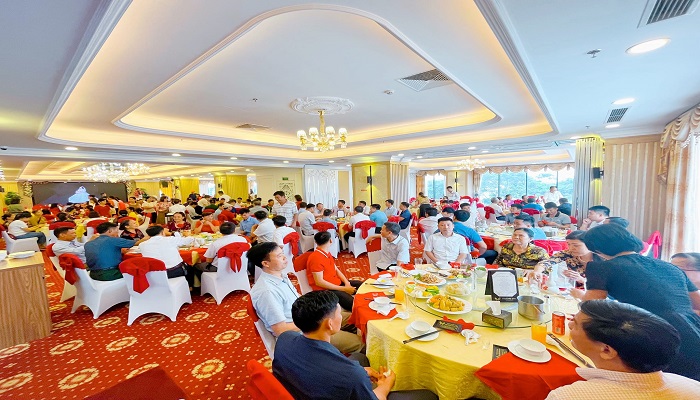The Historical and Cultural Beauty of Vu Dai Village - An Unmissable Journey
I. Where is Vu Dai Village
When mentioning "Chi Pheo", Nam Cao's literary masterpiece, no one is unaware of Vu Dai Village. This place is vividly depicted in work, as well as in the film "Vu Dai Village Back Then". Many are curious, whether Vu Dai Village actually exists or is merely a fictional creation of the author.
Interestingly, this is the hometown of the writer Nam Cao. This land has become an endless source of inspiration for him to create outstanding realistic and critical works. Therefore, Vu Dai Village always attracts tourists who visit Ha Nam.
II. Vu Dai Village Then and Now
Transcending the boundary of fiction, the actual Vu Dai Village is named Dai Hoang Village, famous for its traditional weaving of coarse cloth using crow's beak looms. This place preserves literary traces such as the ancient Bá Kiến house, over a hundred years old, or simple images like the scallion congee of brotherhood or the banana bushes behind the house..jpg)
.jpg)
Visitors to Vu Dai not only explore cultural values but also enjoy delicious local specialties. Ngu banana, seedless custard apple, and Rieng fish stew from Vu Dai Village are dishes that captivate visitors with their rustic and simple flavors.
Vu Dai Village today, with its harmonious beauty between reality and literature, promises to bring unforgettable experiences to visitors.
III. Getting to Vu Dai Village
To get to this destination, you can choose from the following options:
3.1. Take a taxi:
This is the simplest and fastest option, suitable for those who want to save time and effort.Taxi fares from Hanoi to Vu Dai Village range from VND 700,000 - 1,000,000 depending on the time and taxi company.
You can easily book a taxi through ride-hailing apps like Grab, Gojek, and Be, or contact reputable taxi companies directly.
3.2. Ride a motorbike or private car:
If you enjoy exploring and experiencing, traveling by motorbike or private car is an ideal choice.
From Hanoi, take the Hanoi - Ninh Binh expressway, then continue on the Hoa Mac bypass and 379 bypass to reach Ly Nhan.
The travel distance is about 80km, taking around 1.5 to 2 hours.
Along the way, you can visit other famous tourist attractions such as Ba Danh Pagoda, Phat Quang Pagoda, and more.
3.3. Take a bus:
This is the most economical option, suitable for tourists traveling in groups or families.
You can take a bus from My Dinh or Giap Bat bus station to Ly Nhan, Ha Nam.
The bus fare is around VND 60,000/person/way.
Some reputable bus companies on the Hanoi - Ly Nhan route include Khanh Linh, Viet Anh, Hop Tuan, and others.
Note:
Regardless of your chosen mode of transportation, you should research the fare, travel time, and route thoroughly before departing.
Carry all necessary personal documents, cash, and essential items for the trip.
Book accommodation in advance if you plan to stay in Vu Dai Village.
Check the weather forecast before going to prepare appropriate clothing.
IV. Famous Attractions in Vu Dai Village
When visiting this place, visitors feel like they are turning back time, immersing themselves in a distinctive cultural ambiance and exploring unique literary and historical values.
4.1. Bá Kiến House - Symbol of Power and Oppression
Standing out in Vu Dai Village is the Bá Kiến house, an ancient architectural work over 100 years old. The house was built on an area of 900m2, consisting of 3 compartments following the traditional Northern architecture style. The entire house is made of rare limwood, exuding an aura of elegance and authority.
.jpg)
This was once the residence of Mr. Cuu Hanh, a wealthy merchant and influential figure in the village. In the work "Chi Pheo", the Bá Kiến house is described as a symbol of oppression and exploitation by the ruling class over the peasants.
4.2. The Old Brick Kiln - Where the Tragedy of Chi Pheo Began
The old brick kiln is one of the most striking images in the work "Chi Pheo". It is not only a familiar sight in Vietnamese rural villages but also the place where the tragedy of Chi Pheo began, leading him down the path of debauchery and depravity.
.jpg)
By visiting the old brick kiln, visitors can experience the hardship and toil endured by the poor laborers in the old society. This place serves as evidence of the injustice and oppression by the ruling class, causing people to become depraved and lose their sense of self.
4.3. Nam Cao Memorial House - Commemorating the Talented Artist
The Nam Cao Memorial House was built in the writer's homeland to honor his great contributions to the country's literature.
.jpg)
At this place, visitors can learn about the life and career of Nam Cao, as well as express their respect and gratitude for the invaluable work he left behind.

.jpg)


.jpg)








